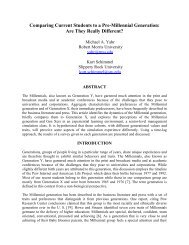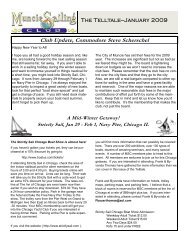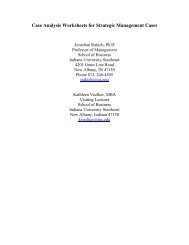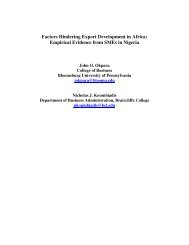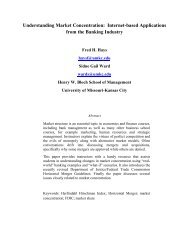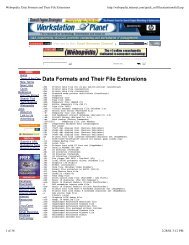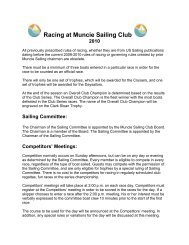Active versus Passive Management of International Mutual Funds ...
Active versus Passive Management of International Mutual Funds ...
Active versus Passive Management of International Mutual Funds ...
You also want an ePaper? Increase the reach of your titles
YUMPU automatically turns print PDFs into web optimized ePapers that Google loves.
allocations. They did not determine whether active or passive management was better, but that<br />
both had compelling strengths and weaknesses. They felt that active and passive management<br />
should be complementary rather than battling to see which one survives [36].<br />
Batten [11] provided a study <strong>of</strong> 22 funds using Morningstar Principia Pro data covering<br />
the 1970 to 1999 period. The results indicated that active management could provide some value<br />
through superior risk adjusted returns. The study was limited in scope and did not adequately or<br />
significantly support the argument for active <strong>versus</strong> passive management <strong>of</strong> mutual funds.<br />
Davis [28] supported the purchase <strong>of</strong> the index instead <strong>of</strong> actively managed funds. He<br />
used the U.S. <strong>Mutual</strong> Fund Database from the CRSP covering the period 1962 to 1998; the<br />
sample consisted <strong>of</strong> 4,687 funds. The significance <strong>of</strong> the study was that all funds during the<br />
period were included, even those that died. The only good news for actively managed funds was<br />
evidence <strong>of</strong> abnormal performance among some <strong>of</strong> the best performing growth funds, but this<br />
performance was not sustainable for more than 1 year [28].<br />
Damato [27] supported the growing trend to indexing. She reported the active managers<br />
did well in 1999, as they achieved an average gain <strong>of</strong> 29.2% <strong>versus</strong> the S&P 500’s 21% return.<br />
In 2000, the S&P 500 lost 9.1% while the active managers lost only 1.3%. Unfortunately, for the<br />
previous 20-year period, the result was much different. She stated that according to Lipper the<br />
average diversified fund returned an average <strong>of</strong> 13.23% while the S&P 500 index returned<br />
15.48% [27].<br />
Frino and Gallagher [40] conducted a narrowly focused study <strong>of</strong> 42 S&P 500 index funds<br />
from the Morningstar Principia Pro CD-ROM, covering a 5-year period ending in February<br />
1999. The study focused on the tracking error <strong>of</strong> the passive fund compared to the index. They<br />
found statistical evidence that tracking error was positively and significantly correlated with<br />
dividend payments from the securities comprising the S&P 500. Additionally, they observed<br />
that, on average, actively managed funds significantly underperform passive benchmarks.<br />
Furthermore, the S&P 500 index funds earned higher risk adjusted returns than active large<br />
capitalization funds. They felt there was no economic benefit for the average investor to invest in<br />
actively managed funds [40].<br />
Israelsen [51] reiterated previous thoughts that active <strong>versus</strong> passive management was not<br />
good <strong>versus</strong> evil, but should be viewed as complementary. He felt both approaches are correct.<br />
The planner, whether selecting active, passive, or a combination <strong>of</strong> both, should stay the course.<br />
Constant change will lead to a loss <strong>of</strong> capital for the client [51].<br />
Adrangi, Chatrath, and Shank [1] revisited the EMH as they tested active manager and<br />
passive index portfolios against randomly selected dartboard selections. They utilized the<br />
Treynor [84], Sharpe [75], and Jensen [52] risk-adjusted portfolio performance measures. Their<br />
findings indicated that active managers beat the short term, 6-month performance <strong>of</strong> the<br />
dartboard portfolios and the market indices. The study findings were limited in scope and<br />
indicated, in the short term, that the market does not reflect all available information [1].<br />
Bogle [17] provided additional support for his findings in Bogle [18] by addressing the<br />
period July 1, 1991 through June 30, 2001. This period included the quiet period <strong>of</strong> 1992 to<br />
1994, the boom <strong>of</strong> 1995 to 1999, and the bust <strong>of</strong> 2000-2001. The results were similar as the small<br />
cap funds outpaced the large and mid cap value funds. The Sharpe ratio <strong>of</strong> the index funds (1.23)<br />
exceeded the average managed fund (0.99), the high cost funds (0.84), and the low cost funds<br />
(1.13) [17]. The only area where active managers appeared to be better was in the small-cap<br />
growth category that was consistent with the previous study.<br />
Fortin and Michelson [38] provided support for index funds, but also identified categories<br />
12



